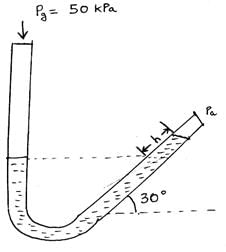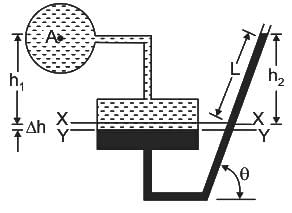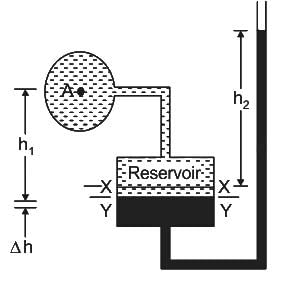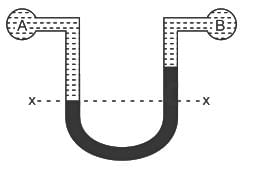Test: Simple Manometer - Civil Engineering (CE) MCQ
10 Questions MCQ Test - Test: Simple Manometer
In a stationary fluid, how does the local pressure of the fluid vary?
A student wants to find the absolute pressure of water at a point below the surface of water. He has a barometer and a manometer pressure gauge. The barometer reads 1.3152 bar where as the manometer pressure gauge reads 0.3152 bar. What is the absolute pressure? (Assume that pressure at one end of the manometer is atmospheric.)
In a U-tube mercury manometer, one end is exposed to the atmosphere and the other end is connected to a pressurized gas. The gauge pressure of the gas is found to be 40 kPa. Now, we change the manometric fluid to water. The height difference changes by: (ρmercury = 13600 kg/m3, ρwater = 1000 kg/m3).
The below figure shows an inclined U-tube mercury manometer. The vertical end of the tube is exposed to a gas of gauge pressure 50 kPa and the inclined end is exposed to the atmosphere. The inclined part of the tube is at an angle of 30o with the horizontal. Find the value of h (in cm) (take g = 9.8 m/s2, ρmercury = 13600 kg/m3)
Find the value of h if inclined part of the tube is at an angle of 30o with the horizontal

What type of reservoir is used in a single column manometer?
Identify the correct statement(s) out of the given options with respect to the inclined U-Tube manometer.
i. More accurate than a U-tube manometer
ii. Measures volume directly
iii. Measures velocity also
Which of the following is NOT a characteristic of the liquid used in a manometer?
In a differential manometer, a head of 0.5 m of fluid A in limb 1 is found to balance a head of 0.3 m of fluid B in limb 2. The atmospheric pressure is 760 mm of mercury. The ratio of specific gravities of A to B is-
A _______ is an instrument used for measuring small pressures, where accuracy is required.





















